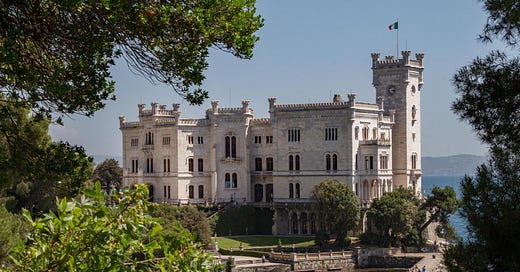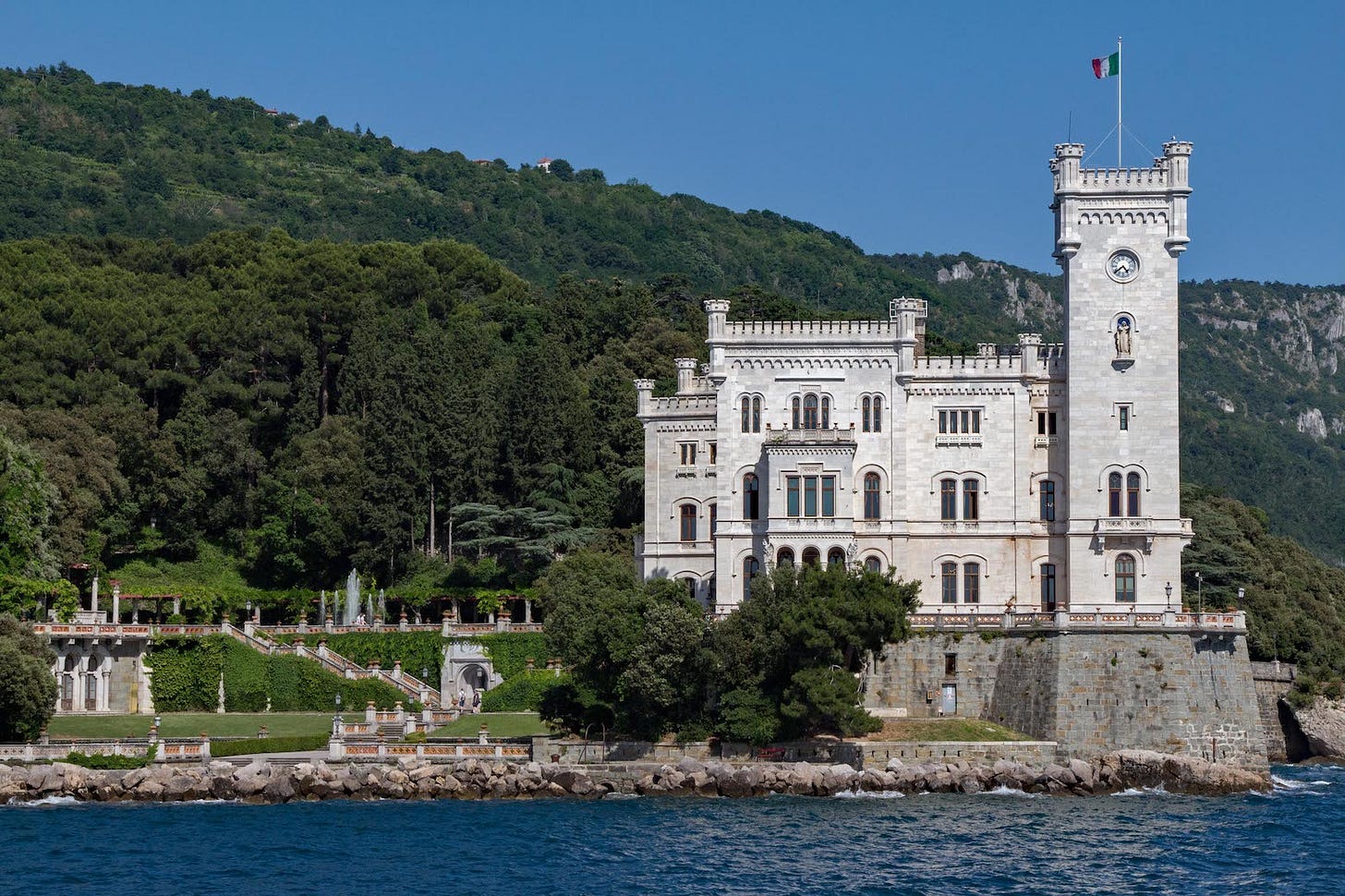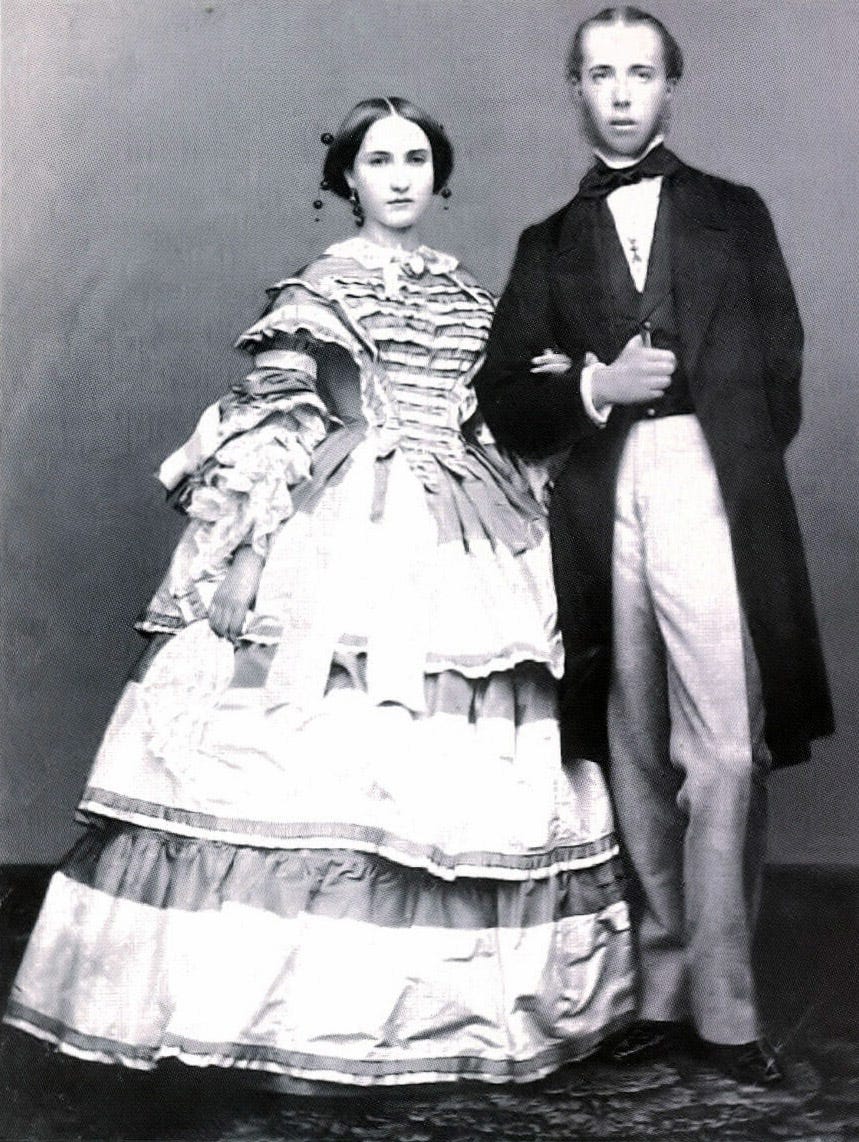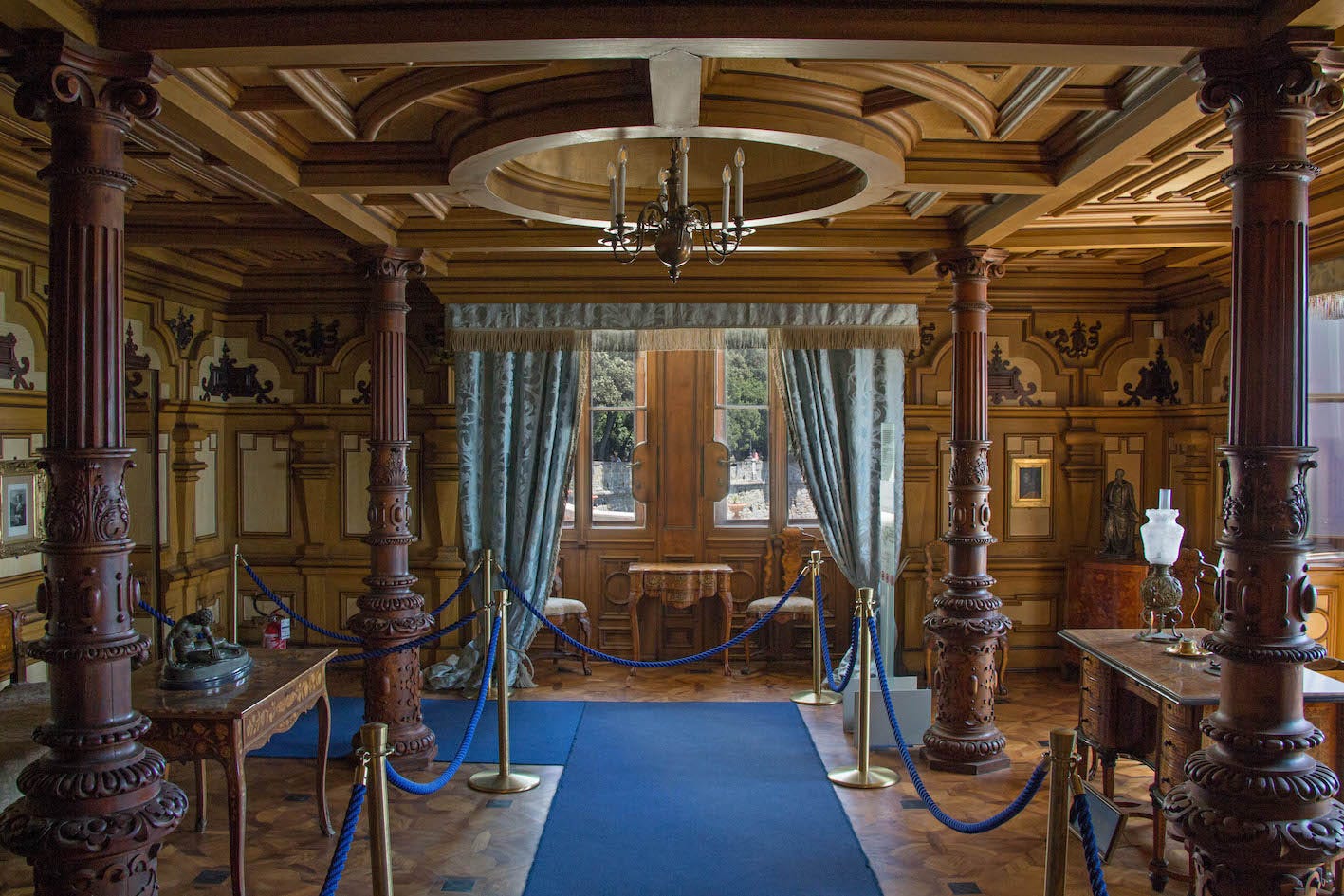Miramare Castle - The Adriatic Paradise
The dream home of one of the most tragic figures of the 19th century is one of Italy's most forgotten wonders...
“O Miramare, around thy fair white towers,
Weary with the weight of rain-burdened sky,
Like some dark cluster of ill-omened birds
Gather the clouds.
O Miramare, against thy granite rocks,
Rising grey from the grim depths of the sea
With a cry of souls maimed
Thunder the waves”
Miramar, Giosuè Carducci
A little under five miles to the west of the great port of Trieste, clinging to the promontory of Grignano, is a castle you might otherwise believe existed solely in the pages of fairytales.
Shining white under even the gloomiest of skies, and commanding the most wondrous panorama of the Triestine Gulf, it is a place where ethereal beauty does battle with haunting melancholy. For Miramare Castle is the immortal legacy of the transcendent dream — doomed to become a dread nightmare — that was the earthly lives of Maximilian of Austria and Charlotte of Belgium, the last Emperor and Empress of Mexico.
Theirs is a tale worthy of the most tragic of epics. Yet their majestic nuptial home, from which Fate would so unceremoniously tear them, remains among the best kept secrets of Italy.
Today, therefore, we cross the threshold of Miramare Castle to recount its origin and construction, share photos of its majestic interior taken by the author of this article (thank you James!), and explore the tragic reasons behind the “Curse of Miramare.”
Now, join us as we discover the beautiful and haunting story of the pearl of the Adriatic. We begin with the man who gave it life — and whose legacy is forever etched into its walls…
The Admiral of Austria
The body of Ferdinand Maximilian of Habsburg, the younger brother of the Emperor Franz Joseph of Austria, enclosed a soul that was unusually adventurous for an Archduke of the House of Austria.
Innocent and curious of the world, Maximilian felt keenly his duty to the Empire and his brother the Emperor — yet it was clear that such a man would be wasted if confined to the court of Vienna. Thus it was that no sooner had the Archduke completed his studies at the age of eighteen than he embarked upon his first voyage to foreign shores.
He would visit Greece, whose antiquities entranced his academic curiosity, and whose dramatic struggle for independence against the Turks captivated his romantic soul. Anatolia and the Dalmatian coast soon followed. A little over a month later, on the 26th October 1850 the inspired Maximilian would commit to the fascination he had held for the sea since childhood, and formally enlist in the Austrian Imperial Navy.
Eagerly seeking experience and service following a posting as a lieutenant and an introduction to the frigate Novara — a ship that would conquer the Archduke’s heart, and one day bear him both to and from his fraught destiny in Mexico — in 1853 Maximilian was granted command of a corvette. It was in such capacities that he rapidly emerged as the strongest advocate of the Navy in all the Empire, and it is largely due to his enterprise that the marine arm of Austria, long neglected by Vienna, was restored to a position it had not enjoyed since the height of Habsburg prestige a century earlier.
The Emperor, recognising his brother’s passion and competence, in the September of 1854 appointed Maximilian Rear Admiral and Commander of the Imperial Navy. Quite apart from the near total Renaissance in the fortunes of the Navy that he presided over, the personal crowning achievement of this stationing was the circumnavigation of the globe by the Novara, the first such voyage by any Austrian warship, from 1857-1859, and the scientific expedition that accompanied it and which the Archduke made possible.
Successful and celebrated, Maximilian was at home with the Navy, and by its headquarters he would now build a home…
The Seat of a Sea-Lord
With the port of Trieste rapidly expanding to accommodate both the growing Navy and all those industries that supported it, the new Admiral was in need of a residence that would allow him to call the Gulf his stable home. In the fall of 1855, while seeking shelter from a tempest in the bay of Grignano, he would find it.
A bare outcrop of karst, around a league to the west of the port, and connected to it by naught but emerald forest and waters of near tropical clarity, entranced the Archduke particularly. When the weather returned clement, Maximilian swiftly purchased a plot of land there, whose extent was far more modest than might be expected for the home of so stately a gentleman of Europe. To raise a home upon these rocks, he turned to the engineer Carl Junker, who having recently worked on the Suez Canal, happened to be present in Trieste while designing the nearby Aurisina Aqueduct.
Following the briefest exchange, the second proposal of Junker met with the Archduke’s pleasure, such that the foundation stone of Miramare had already been laid by the 1st March 1856. The Neo-Gothic design, blending the castles of Germany with the towers of the Iberian Atlantic coast, would echo its owner’s soul — rooted in a romantic past, yet distinctly modern in its interpretation of that past.
Junker’s plan for two years of construction would prove rather optimistic. Fortunately Fate, otherwise the invariable enemy of Maximilian, would see the Archduke immediately spared an impatient wait…
A Wedding Home
Maximilian’s many travels would be reflected in the stones and gardens of his fledgling residence, and by travel it would be enriched further still when in the February of 1857, the Emperor appointed him as Viceroy of the Kingdom of Lombardy-Venetia, the Austrian Crown Lands of Italy.
Relocating thence to Milan, where he would succeed the brilliant but ruthless Field Marshal Radetzky, Maximilian would seek in earnest to reconcile the Lombards to the Empire, as the war drums of Italian nationalism grew ever louder in neighbouring Turin. In this endeavour he would almost succeed, bringing a velvet glove in place of Radetzky’s iron fist. His time, however, was too fleeting, and his appointment too late, and following months of obstruction from the government in Vienna, Maximilian was withdrawn in 1859. Soon after, the Second War of Italian Independence erupted, and Lombardy was lost forever.
Yet when the Archduke returned now to the Navy, his absence had not been entirely wasteful on a personal level. For during his tenure as regent, on the 27th July 1857, he had wed the Princess Charlotte of Belgium, daughter of Leopold I, King of the Belgians, consecrating one of the great royal love stories of history. The castle at Grignano, formerly a solitary retreat, was now to be a marital home, and in this transformation, as with so many of the labours of Maximilian, Charlotte would be an enthusiastic partner.
“Mira el mar” — “Look at the sea!” — the Archduke is said to have exclaimed in awed Spanish, recalling the Atlantic coasts of Spain as he gazed at the waters of the Gulf from the promontory, and it is from this that ‘Miramar’ Castle would take its name, before being rather bluntly Italianised into ‘Miramare’. The new Archduchess, too, was entirely taken with her new waterfront home, which inspired her to indulge her passion for watercolour painting.
Several such works indeed decorate the Castle today, including what is perhaps the most marvellous room of Miramare.
As the beautiful wood-panelled study of Maximilian, the Sala Novara incarnates that greatest of the Archduke’s passions — for the unusual space, made possible by the interior designers Franz and Julius Hoffman, recreates the officer’s quarters on the SMS Novara, Maximilian’s beloved frigate.
Keep reading with a 7-day free trial
Subscribe to INVICTUS to keep reading this post and get 7 days of free access to the full post archives.









